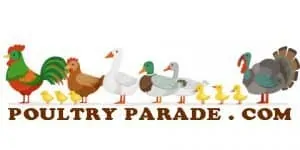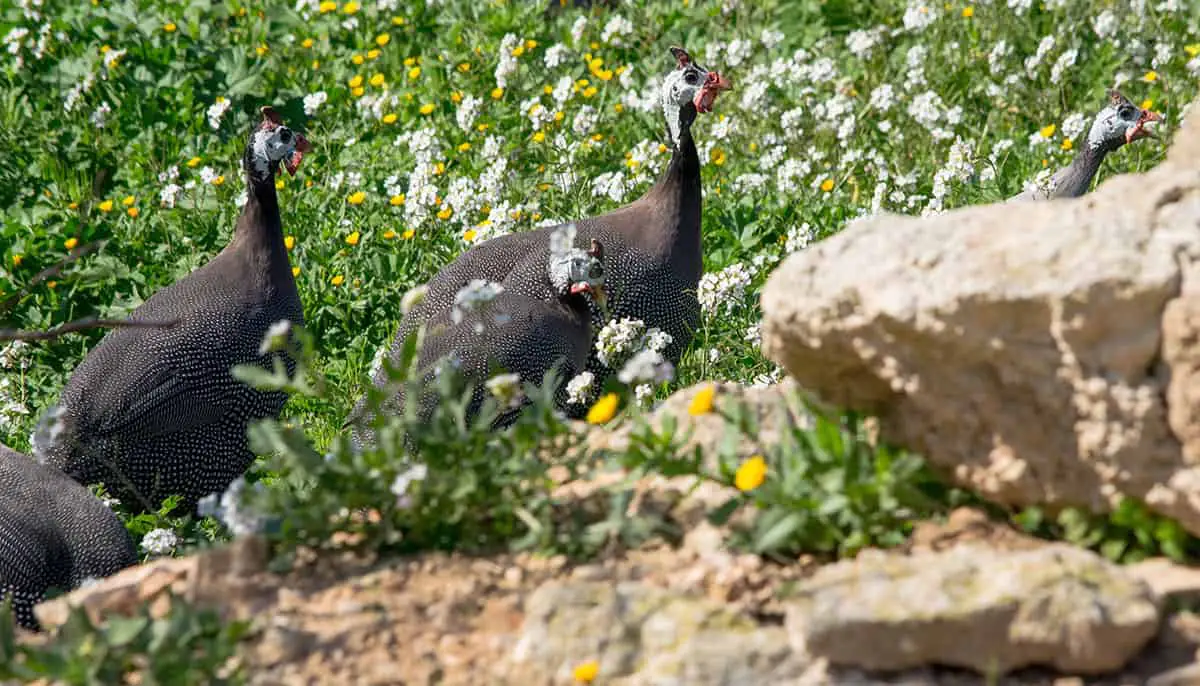Keeping guinea fowl can be a challenge to anyone used to keeping traditional poultry like chickens and ducks for a few reasons. One of these reasons is that they are more difficult to tame compared to chickens.
Another major difference between guinea fowl and chickens is that guinea fowl can fly considerably long distances; they do not just flap their wings and leap but can actually take flight.
This ultimately means that keeping them at home and inside a fence is going to be a challenge. Unless guinea fowl know that the coop or space you have built for them is their home or safe haven, they will not hesitate in just flying away, never to return.
Guinea fowl can fly 400 to 500 ft in one “jump” which puts them in the category of strong fliers. But there are certainly ways to keep them from flying away and this guide will discuss all of them in detail.
In short, guineafowl are able to fly considerable distances but there are ways to keep them from flying away. That includes total confinement, release methods that make use of their flock mentality, or you can train them to enter their enclosure at night. Clipping wings can also be useful to some extent, but there are issues associated with that which you may want to avoid
Before exploring the ways to keep guinea fowl at home and prevent them from flying away, it is important to understand their general behavior if you are planning to keep them.
Table of Contents
Guinea Fowl Living Space
Large coops with high perches and over the top nesting boxes do not really help keep guinea fowl at home. They fly high and no fence is high enough to restrain them.
The only coop that will keep them inside and constrained is something with a total enclosure which means that the top is covered with netting too.
But, if guinea fowl are well trained, they will return to the coop at night. Although you may still occasionally find them roosting in a tree at night.
Tame the Guinea Fowl Keets
Keets is just another name for guinea fowl hatchlings. The best way to tame guinea fowl is to purchase keets. You can buy day-old keets.
Handling them frequently will help them get used to you. Keeping them in an escape-proof pen will help keep them safe from predators as they are notorious for jumping out.
The place where they are kept and raised as keets can become the place they return to. Decide on the place where you plan to keep them and raise them there.
It will eventually become their forever home. If you decide to move them somewhere, there is a great chance of them wandering away. To prevent that from happening, you will have to train them all over again using a strategy of confining and releasing one at a time.
You should also keep a small light inside their coop, enclosure, pen, or shed as they are reluctant to enter dark places.
Raising Keets
You will need a heat lamp and brooder for keets. Guineas do not make the best mothers, so it is best to not rely on them for raising or hatching keets. Besides the essentials, you will also need adequate feed.
Keets require a higher amount of protein in their diet compared to chicks. You can start them off on 28% turkey starter or game bird starter or purchase an unmedicated chicken starter and add protein in it. After a few weeks, you can start enticing them with treats and train them.
Taming Adult Guinea Fowl
If you want to add guinea fowl to your flock, it is recommended to buy them as keets and raise them to tame them. If you decide to add adults, you may have some trouble in keeping them from flying away, particularly if you want to free-range them instead of keeping them in a total enclosure.
The first thing that you must do when you get adult guinea fowl is to keep them in an enclosure or coop from which they cannot fly away. You will need to keep them in that living space for at least six weeks. Make sure all their needs are met while they are caged.
Once, they have gotten used to that cage or coop, let only one male out of the enclosure. For three to four days, repeat this process. This works because males tend to return to where females or hens are kept.
When a few days pass, allow another male to leave the enclosure. Now repeat the same process for the whole flock. One way to let them know that the coop is their home is to inveigle them with treats and a good feed. They will associate coop with feed and treat and learn to return.
Safe Treats for Guinea Fowl
Keepers tell many interesting stories of guinea fowl flying back to the coop for a bit of treat. Treats and scratch work when it comes to luring guinea fowl back home. But you must know what treats are good for your fluffy flock.
Most of the keepers swear by white millet as a guinea fowl treat while keeping whole corn kernels at bay as guinea fowl dislike if not detest them. They also tend to like sorghum, wheat, and millet grain. Mealworm is another great option to give your guinea fowl flock as treat.
Besides the options already mentioned, you can find your guinea fowl’s other favorite treat in this list:
- Grapes
- Cabbage
- Kale
- Tomatoes
- Chicken Scratch
- Watermelon
- Cottage Cheese
- Bugs
- Corn
- Sunflower Seeds
Not all the things in the kitchen make safe treats for your guinea fowl. Here is a list of things that you should not feed to guinea fowl:
- Potato Peels
- Avocado
- Chocolate
- Sugary Food
- Uncooked Beans
- Salty Snacks
Use the much-loved treats as a teaching or training tool. Give your guinea fowl treats when they show correct behavior like returning to the coop at night.
Clipping Guinea Fowl Wings
Some keepers clip guinea fowl to keep them from flying away. Some keepers believe that clipping one side is effective, but it makes guinea fowl vulnerable to predators as they may still fly but may not be able to keep their balance.
Clipping wings is generally not useful because guinea fowl are still able to fly considerable distance with clipped wings. They have been known to fly/jump 5 feet fences with clipped wings which only tells how ineffective the solution is.
If their wings are not clipped, they can fly away from potential dangers like cats, dogs, etc. If you decide to try this alternative, make sure to do your research on how to properly clip their wings.
Total Enclosure for Guinea Fowl
Guinea fowl can help eradicate bugs completely when they are allowed to forage which makes them great birds for pest control.
They are very independent and are able to fend for themselves. In case you decide to keep guinea fowl confined in an enclosure, it is important to make sure that the enclosure has enough space for them. A total enclosure is covered at the top too like a cage.
Guinea fowl need adequate space per bird in an enclosure which comes down to around 3 sq. ft. of space per bird. Not having enough space will cause stress. They also like to roost; hence, you need to provide them with perches. Provide them with proper bedding of your choices like straw or wood shavings.
In a covered pen where guinea fowl are unable to forage, you become responsible for providing them with enough feed. Unmedicated chicken feeds in the mash or crumble form is recommended for guinea fowl. They do not prefer pellets. You can also add variety to their diet by feeding them vegetables, fruits, and bugs.
Associating a Call
Many keepers also use a specific sound to call guinea fowl home which resembles the guineas “pie-qua” sound.
Every time you give them a treat, remember to use the same call. They will associate the call with treats and come home when you call. Besides, this can help you tame them.
Final Words on Keeping Guinea Fowl from Flying Away
Guinea fowl are not the most intelligent birds and hard to confine. They may find themselves in danger often and despite all the measures, they may end up resting on a nearby tree.
Your best bet to keep them safe is to provide enrichments and incentives to return home. This can be in the form of treats, feed, and water.
Guinea fowl are flock-oriented and follow each other blindly which means if one guinea fowl calls the flock, others will certainly follow. You can use this trait or flock mentality to your advantage and keep them from flying away.
Use the confinement and release one at a time method to teach them that the shelter you are providing is their safe home. When the flock calls, the flock mates that are outside will return to the coop. Be consistent in your efforts.
Consistency is the key in taming guinea fowl, do not get discouraged easily. With these measures, you will definitely succeed at keeping your guinea fowl from flying away.


